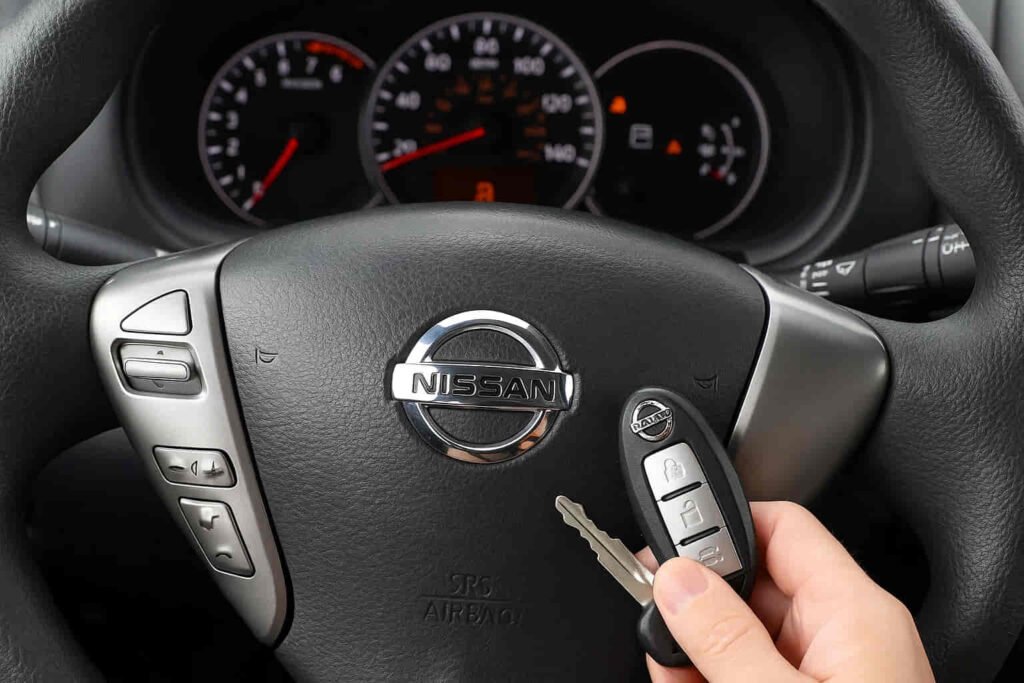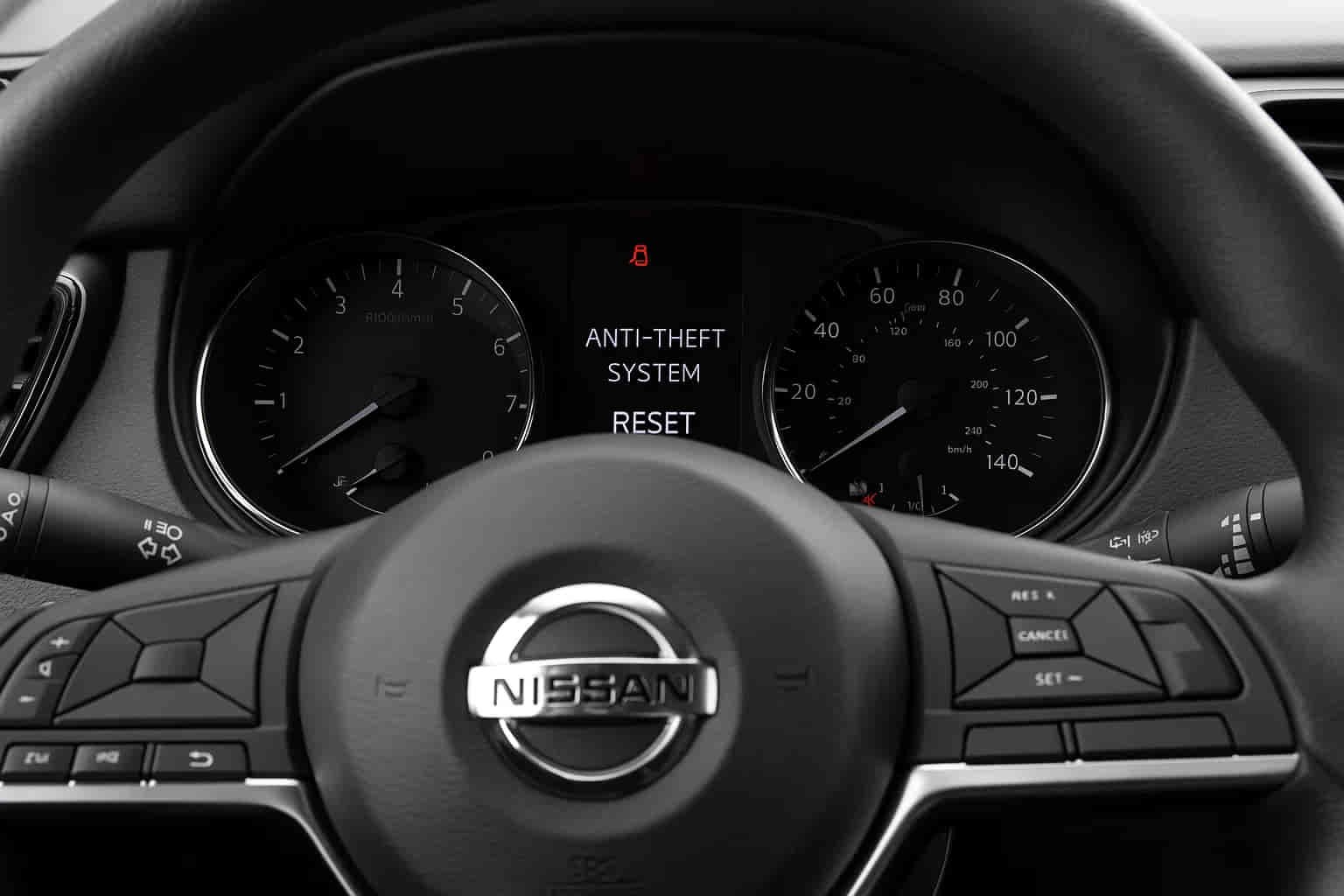Getting stranded in a parking lot because your Nissan refuses to start is one of the most frustrating situations a driver can face. You turn the key, the engine stays silent, and the small red security light on the dashboard blinks relentlessly. This is the moment most owners realize that the vehicle’s anti-theft system has been triggered. The Nissan Anti-Theft System Reset is not just a technical trick but a lifeline that can help you regain control of your car without immediately paying for dealership intervention. Many Nissan drivers encounter this problem after replacing a battery, swapping a key fob, or experiencing a sudden electrical fault, and the confusion often leads to unnecessary tow bills or expensive locksmith services.
The good news is that the immobilizer system in your Nissan can often be reset with a few proven steps that require no special tools. This guide explains how the anti-theft lock works, why it sometimes mistakes the rightful owner for a potential thief, and how you can carefully reset it to bring your car back to life. By the end, you’ll not only understand the logic behind the system but also know the exact sequence to fix it quickly and safely.
Why the Nissan Anti-Theft System Activates (Cause & Symptoms)
The anti-theft system in Nissan vehicles is designed to recognize authorized keys and protect the engine from unauthorized starts. While this technology adds an important layer of security, it can also misfire and prevent the rightful owner from driving. In most cases, the Nissan Anti-Theft System Reset becomes necessary after something interrupts the communication between the key, the immobilizer, and the vehicle’s electronic control unit.
A weak or dead battery in the key fob is one of the most common triggers. When the fob cannot send a strong signal, the immobilizer reads it as an unknown key and activates the lock. Similarly, disconnecting or replacing the car battery may clear stored data and confuse the security module, leading the system to assume the vehicle is under attack. Other scenarios include attempting to start the car with a worn physical key, interference from nearby electronic devices, or a sudden fault in the ignition switch.
Drivers usually recognize the issue by observing the security light on the dashboard. A blinking red indicator often means the system does not detect a valid key, while a steady light can signal a deeper fault in the immobilizer. The result is always the same: the engine refuses to start, leaving the owner stuck until the system is reset or reprogrammed.
Step-by-Step Nissan Anti-Theft System Reset Methods

Using the Key Fob Panic and Lock/Unlock Cycle (Rewritten)
If your Nissan’s security system has locked the car and the engine will not start, a surprisingly effective first step is to use the key fob to recreate a clear signal that the vehicle recognizes. Begin by standing close to the car and pressing and holding the panic button on the fob for about five seconds until the horn or lights react, then release. Immediately follow by pressing the lock button once and then the unlock button once in quick succession. This deliberate sequence sends a fresh communication burst to the immobilizer and often forces the security module to re-evaluate the fob’s credentials.
Many drivers dismiss this as a gimmick, yet it works because the immobilizer sometimes needs an unmistakable radio handshake to accept the key after a brief interruption or interference. If the trick succeeds, the flashing security indicator should stop and the car will allow a normal start. If nothing changes, check the fob battery next, because a weak cell can make the signal too faint for the immobilizer to register. Use this method as your first, low-risk attempt before moving on to more intrusive resets or professional programming.
Reset by Using the Physical Key in the Driver’s Door (Rewritten)
When the Nissan anti-theft system refuses to recognize the key fob, the traditional mechanical key hidden inside the remote can serve as a reliable backup. Slide the metal key into the driver’s side door lock and turn it to the unlock position. Hold it there for about thirty seconds, allowing the vehicle to register that the action comes from a genuine, coded key. After the hold, return the key to its neutral position, remove it, and then try starting the car.
This method works because the immobilizer isn’t just electronic; it also listens for manual signals from the factory-installed lock cylinder. By holding the key in the unlock position, you are essentially reassuring the security module that the person using the car has authorized access. Owners of models such as the Nissan Altima, Pathfinder, and Rogue often find this especially effective after a dead battery or electrical reset, when the immobilizer becomes overly sensitive.
If the security light goes out after the attempt, the reset has succeeded. If not, it’s a sign that the problem lies deeper in the communication between the key and the control unit, in which case another reset method—or eventually dealer programming—will be required.
Ignition ON–OFF Cycle (Rewritten)
Another effective way to perform a Nissan Anti-Theft System Reset is by using the ignition switch itself. Insert the key into the ignition and turn it to the ON position without cranking the engine. Leave it there for about five minutes, giving the immobilizer and electronic control unit enough time to recognize the key’s signal and reset the security protocol. After the waiting period, turn the ignition back to OFF for at least ten seconds. Repeat this cycle two or three times before attempting to start the car.
This method works because the immobilizer sometimes becomes “stuck” after a weak battery, repeated failed start attempts, or an electrical interruption. Allowing the key to sit in the ON position gives the system a chance to resynchronize and clear the error. If successful, the flashing security light on the dashboard should turn off or remain steady before you try to start the engine.
Patience is important here. Rushing through the cycle or skipping the waiting time often leads to failure. While this technique doesn’t require special tools, it is not guaranteed to solve deeper immobilizer faults. If the security light continues blinking after several attempts, the system may need a more direct reset method or dealer-level programming.
Battery Disconnect & Reconnect
When the anti-theft lock refuses to clear after using the key fob or ignition cycle, a hard reset through the vehicle’s battery can sometimes restore proper function. Begin by disconnecting the negative terminal of the car battery and leaving it disconnected for at least fifteen minutes. This pause allows residual electrical charge in the system to dissipate, effectively clearing temporary glitches in the immobilizer and electronic control modules. After the wait, reconnect the terminal securely, turn the ignition to the ON position, and watch the security light. If the reset has worked, the blinking indicator should stop, and the car will be ready to start.
This method works much like rebooting a computer: by cutting off power, you force the system to reload its internal communication routines. It is especially useful after events such as battery replacement, jump-start attempts, or electrical surges that confuse the anti-theft module.
However, drivers should be aware that disconnecting the battery may also reset other electronic settings, including radio presets, clock, and in some cases even ECU learning data. For that reason, this approach is best used when simpler reset techniques have failed. If the problem persists even after a battery reset, it is a strong indicator that the immobilizer requires professional reprogramming.
Professional Reset via Nissan Consult-II / Dealer Tools
If none of the do-it-yourself techniques succeed, the most reliable option is a professional reset using Nissan’s factory diagnostic equipment. Dealerships and certified locksmiths rely on tools such as the Nissan Consult-II or Consult-III Plus to directly communicate with the immobilizer control unit and reprogram the system. Unlike basic fob synchronization or battery resets, this process accesses the car’s secure database and re-establishes a verified connection between the key, immobilizer, and engine control module.
The professional reset is often required when a new key or fob is being added, when the immobilizer hardware has developed a deeper fault, or when previous attempts at manual resets have failed. Although the service can cost more—typically ranging from $100 to $300 depending on the model and region—it guarantees accuracy and restores the system to its intended factory condition. In many cases, the technician may also update the vehicle’s software to fix known immobilizer bugs or improve signal recognition.
While calling a dealer may feel inconvenient, it prevents endless trial-and-error and protects you from disabling the system further. For owners who depend on their vehicle daily, professional programming is the ultimate peace of mind, ensuring the Nissan anti-theft system functions exactly as designed.
Troubleshooting Nissan Security Light Issues
The security light on your Nissan’s dashboard is more than a simple indicator; it is the system’s way of communicating the immobilizer’s status. Learning to interpret its behavior can help you decide whether a basic Nissan Anti-Theft System Reset will solve the problem or whether professional assistance is required.
When the light blinks rapidly while the ignition is in the ON position, it usually means the system does not detect a valid key signal. This could be caused by a weak fob battery, interference from other electronics, or a key that has lost its programming. If the light remains solid and does not turn off, it often points to a deeper fault within the immobilizer module or a wiring issue that prevents the system from completing its handshake with the ECU. In some cases, the light may fail to illuminate at all, which can indicate a blown fuse, a disconnected circuit, or even an immobilizer unit failure.
Pay attention to the timing as well: if the light blinks only when the car is locked, that is normal. The problem arises when the pattern continues inside the cabin and prevents the engine from starting. By reading these signals correctly, you can quickly determine whether a simple reset will restore function or whether the issue lies deeper in the vehicle’s electronic security system.
When DIY Reset Isn’t Enough: Dealer Programming & Costs
Sometimes even after trying every home reset method, the Nissan anti-theft system remains locked. In these situations, the issue often lies beyond a simple synchronization error and requires professional intervention. Dealerships and licensed automotive locksmiths have access to Nissan’s official diagnostic platforms, such as the Consult-III Plus, which can directly reprogram the immobilizer and pair it with the vehicle’s keys.
The cost of this service typically ranges between $150 and $350, depending on the model, year, and location. While the price may feel high compared to a do-it-yourself attempt, it guarantees precision and avoids the risk of damaging sensitive electronic modules. In many cases, the service fee also includes the programming of additional keys or software updates that improve system reliability.
Choosing professional programming is particularly important if the immobilizer itself is faulty, if the keys have been lost or replaced, or if repeated reset attempts have failed. Unlike temporary fixes, dealer-level programming ensures the system operates exactly as designed, restoring the highest level of security.
Although it may seem like the last resort, professional programming provides peace of mind. Instead of worrying whether the car will refuse to start again tomorrow, you can drive away knowing the immobilizer and keys are properly aligned, protecting your Nissan without disrupting your daily routine.
Preventive Tips to Avoid Future Lockouts
Avoiding another immobilizer lockout starts with simple habits and preventive care. The Nissan anti-theft system is sensitive, and many of its problems arise not from hardware failure but from overlooked details that disrupt the connection between the key and the vehicle’s security module.
The first line of defense is the key fob battery. Replacing the coin-cell battery every year, or sooner if you notice weaker range, ensures the immobilizer receives a strong and reliable signal. Keeping a spare key fob programmed and ready is equally valuable, since having only one working key leaves you vulnerable if it suddenly fails.
Pay attention to where you store your keys as well. Strong magnetic fields, RFID blockers, or even other electronics in close proximity can interfere with the chip’s ability to communicate. Owners should also avoid leaving the key fob in extreme temperatures, which can shorten battery life and damage internal circuits.
Finally, get familiar with the security light patterns on your dashboard. Recognizing the difference between a normal blinking light when the car is locked and an abnormal flash sequence when trying to start the engine will help you act quickly before the issue escalates. These small steps not only prevent future lockouts but also preserve the long-term reliability of your Nissan’s anti-theft system.
Conclusion
The Nissan anti-theft system is a valuable safeguard, but when it mistakes the owner for an intruder, it becomes a major source of frustration. Knowing how to perform a Nissan Anti-Theft System Reset gives you the confidence to handle lockouts without immediately turning to costly professional help. From the simple panic button sequence to the ignition cycle, battery reset, and even the physical key override, each method offers a practical way to bring your vehicle back to life. For most drivers, these techniques are enough to clear the error and get back on the road within minutes.
However, it is important to recognize when a deeper issue is at play. If the security light continues to blink or the immobilizer refuses to accept your key, dealer-level programming is often the only reliable fix. While it may involve a higher cost, it ensures the system is properly aligned and prevents recurring problems that can waste both time and money.
By understanding the causes, symptoms, and reset procedures, you reduce the stress of unexpected lockouts and gain control over a system that often feels mysterious. Keep these steps in mind, share them with other Nissan owners, and you’ll never feel helpless again when faced with a sudden anti-theft activation.

